You’ve heard a lot about both platforms and now you want a verdict on which platform will be better for your team: Asana or monday.com.
Asana’s work management platform facilitates team collaboration and project management. On the other hand, monday work management — one of monday.com’s core products alongside monday CRM and monday dev — enables teams to build cross-departmental workflows and execute projects faster. Both are great options, but which is the best one for you?
In this guide, we’ll compare both Asana and monday work management’s features, pricing plans, support options, user reviews, and more so you can decide which platform is best for you.
monday work management offers better value and is easier to use
If you’re short on time, we’ll cut right to the chase: while they’re both popular project management tools, monday.com comes out on top. It’s not that we’re biased, but we’ve compared the two side-by-side and considered tons of different factors, like pricing, usability, project and task management features, and even looked at what real users have to say and the verdict is clear.
While Asana is still a leading project management platform with many great aspects, monday work management, built on the monday.com Work OS, is more customizable, flexible, and user-friendly. Want to get into more of the nitty-gritty details? Keep reading.
monday work management vs Asana: At a glance
Here’s a quick overview of each platform to give you the key information you need. Below, we’ll look at a more detailed breakdown of each factor.
| Asana | monday work management | |
| Pricing | Free basic plan with paid plans starting at $10.99/user/month | Forever free plan with paid plans starting at $9/seat/month |
| Free plan | Free forever plan with limited features | 14-day free trial |
| Features | Views Reporting Workload Automations | Dashboards Views Collaboration tools Automations |
| Task management | Set owners, deadlines, subtasks, and add potential blockers and custom labels to filter tasks | Minimize manual tasks with automations and turn tasks list into a unique workflow |
| Integrations | 100+ | 200+ |
| Storage | Unlimited storage | 5GB - 1000GB depending on plan |
| Security | GDPR SOC 2 HIPPA CSA FERPA GLBA ISO 27001 | ISO 27001 ISO 27017 ISO 27018 HIPAA GDPR AICPA SOC1, SOC2, SOC3 CSA |
| Ease of use | Easy to use but with a learning curve to get started for less tech-savvy users | Intuitive and user-friendly for all users, quick to get started and onboard |
| Support | Email and chat only | 24/7 phone, email, and chat |
| Customer reviews | 4.4/5 on G2 | 4.7/5 on G2 |
Features: monday work management offers more robust features
Both work management platforms help teams organize, plan, prioritize, and track tasks and projects. While Asana positions itself as a task management tool, monday work management enables organizations to build cross-departmental workflows and efficient processes. Let’s take a look at each platform’s standout features.
Asana features
Asana enables teams to collaborate on tasks, break down large tasks into subtasks for easier management, and organize their work in one place.
Views
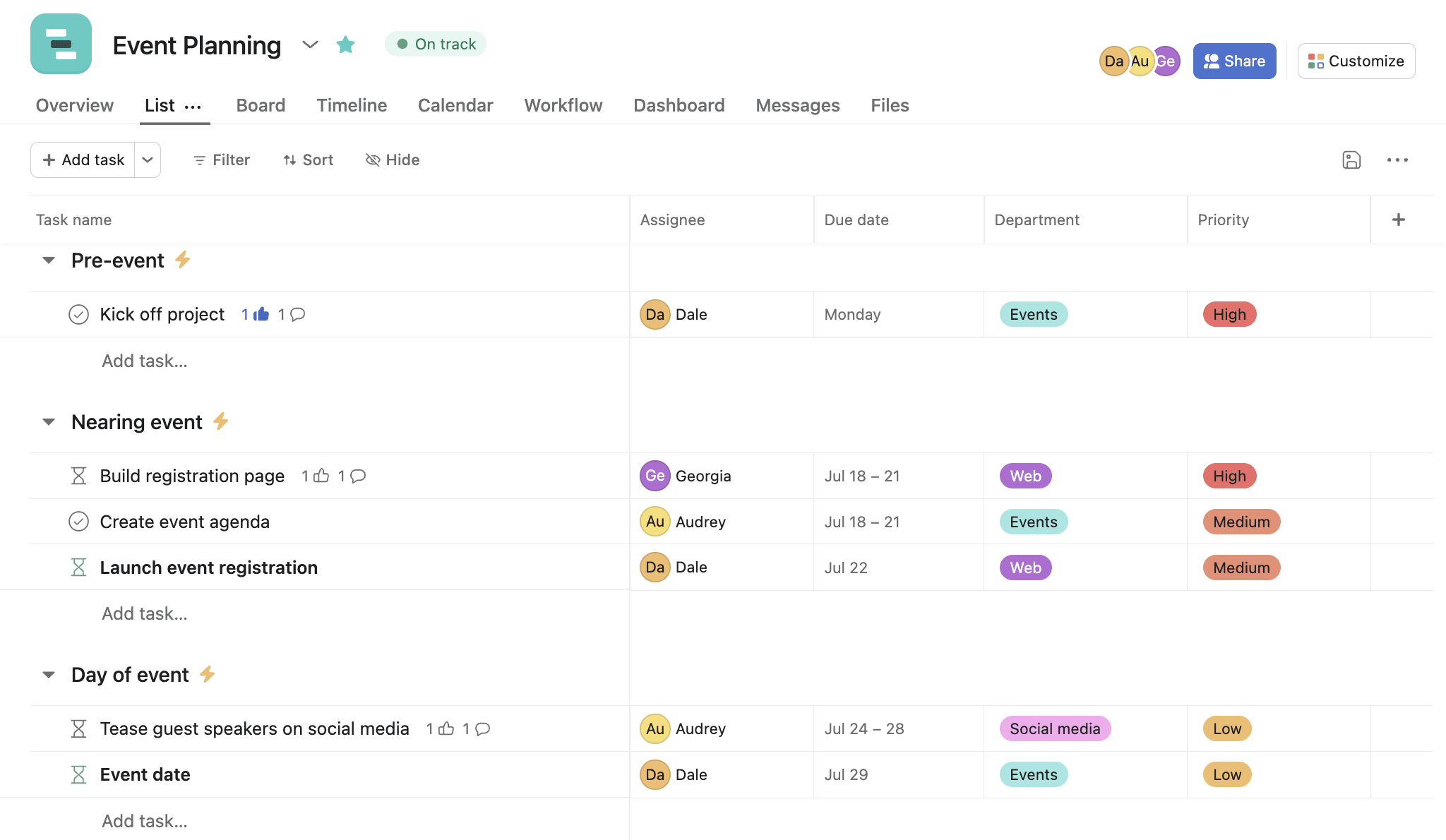
Asana includes various views — such as List, Timeline, Calendar, Kanban boards, and Gantt charts — to help teams manage projects efficiently. Users can see which tasks to prioritize, manage overlapping and unscheduled tasks, and keep work on track as things change.
Reporting
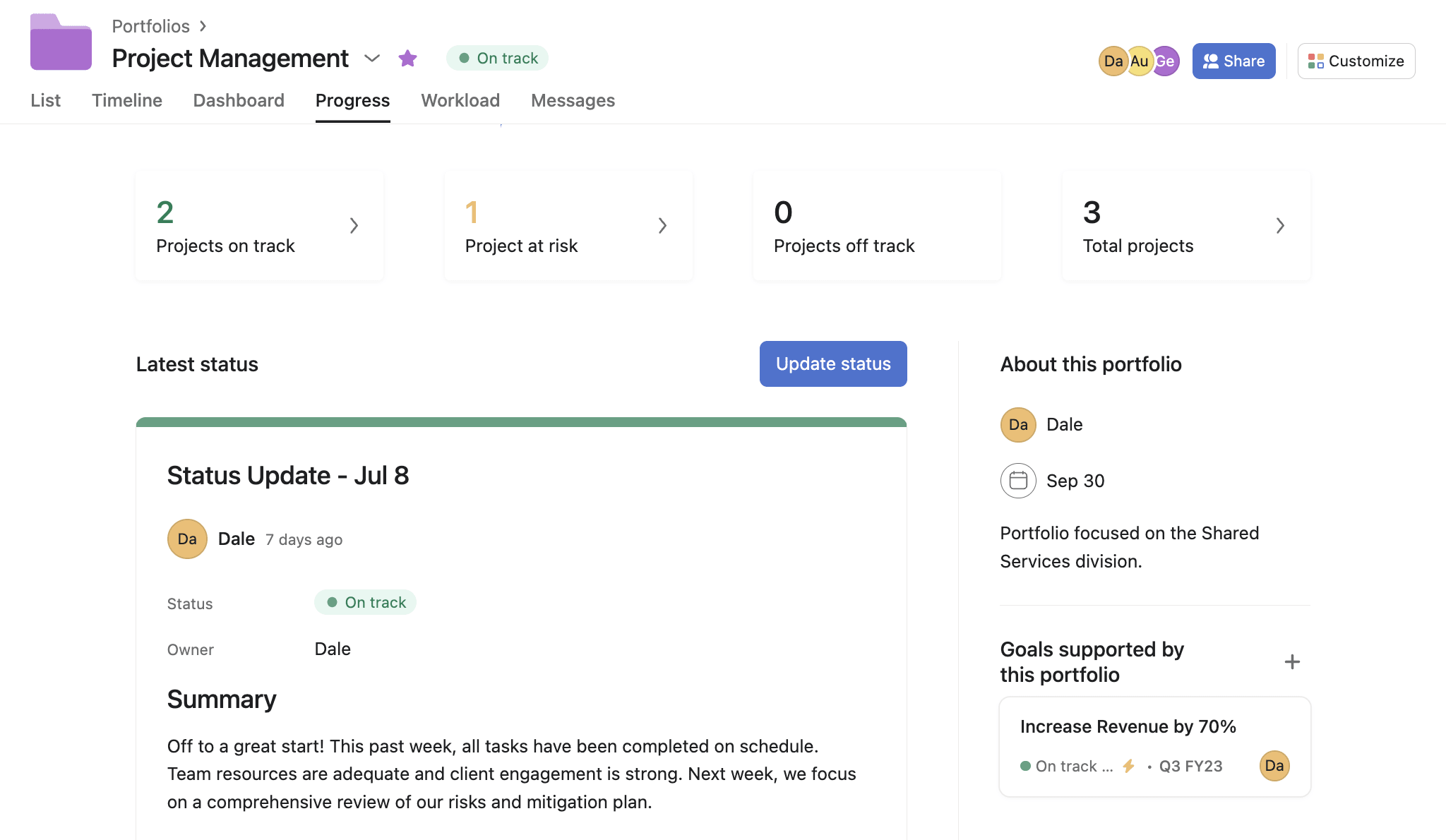
Asana’s universal reporting lets you track team performance and monitor the status of tasks in real time. You can gauge project progress, troubleshoot problems, and keep work on track in one place.
Workload

Asana’s Workload feature lets you check how busy team members are across projects in one central view. Users can set restrictions on team members’ workloads and ensure no one is underworked to keep projects on track.
Automation

Asana’s suite of Automation features allows you to create custom rules to automate routine tasks, simplify workflows, and reduce errors.
Task management
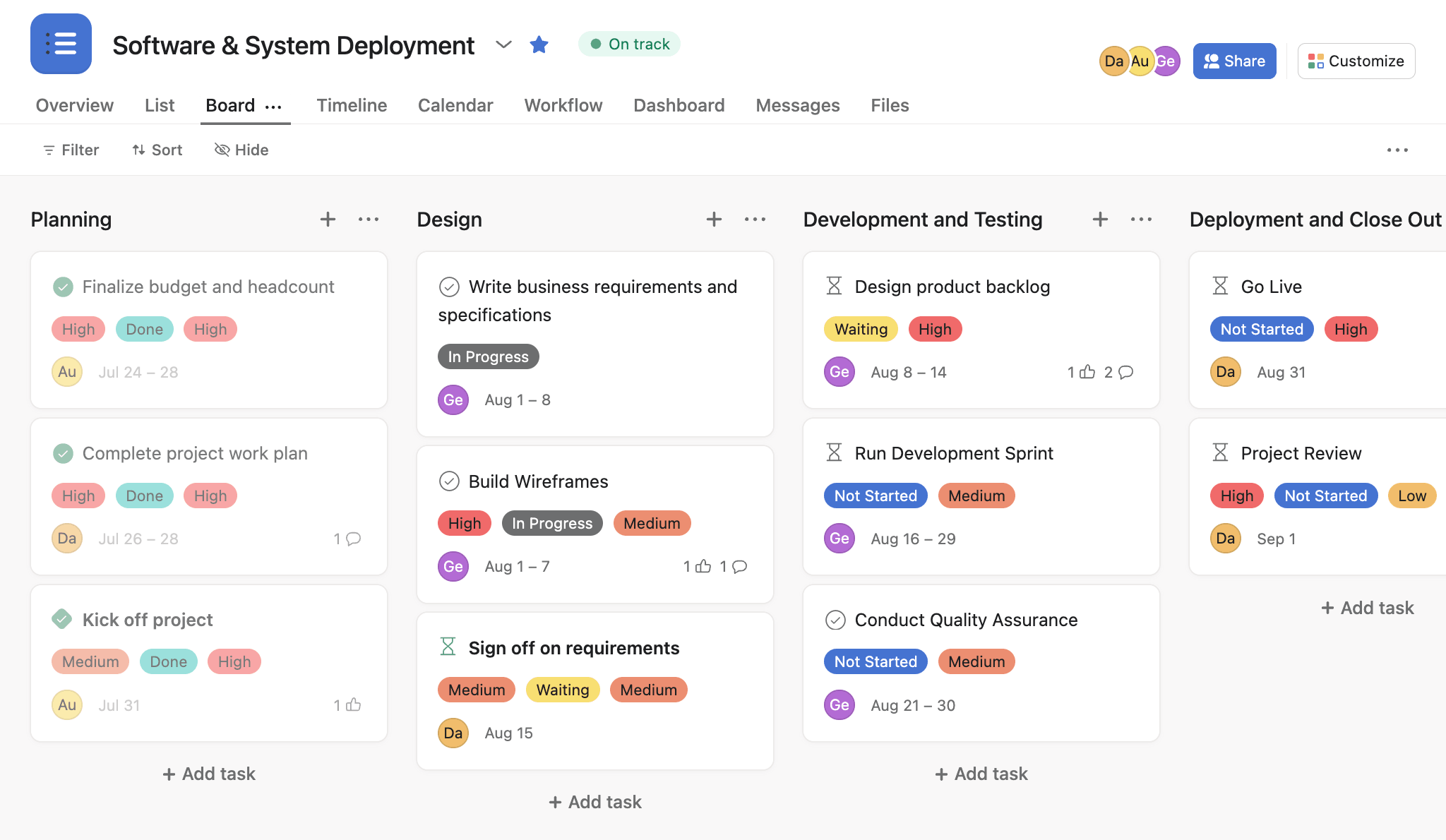
Organize tasks in one place and set owners, deadlines, subtasks, task dependencies, and more. A task manager can describe the work on each task, add potential blockers that may affect the work, and add custom labels to tasks so you can filter them as needed.
Analytics
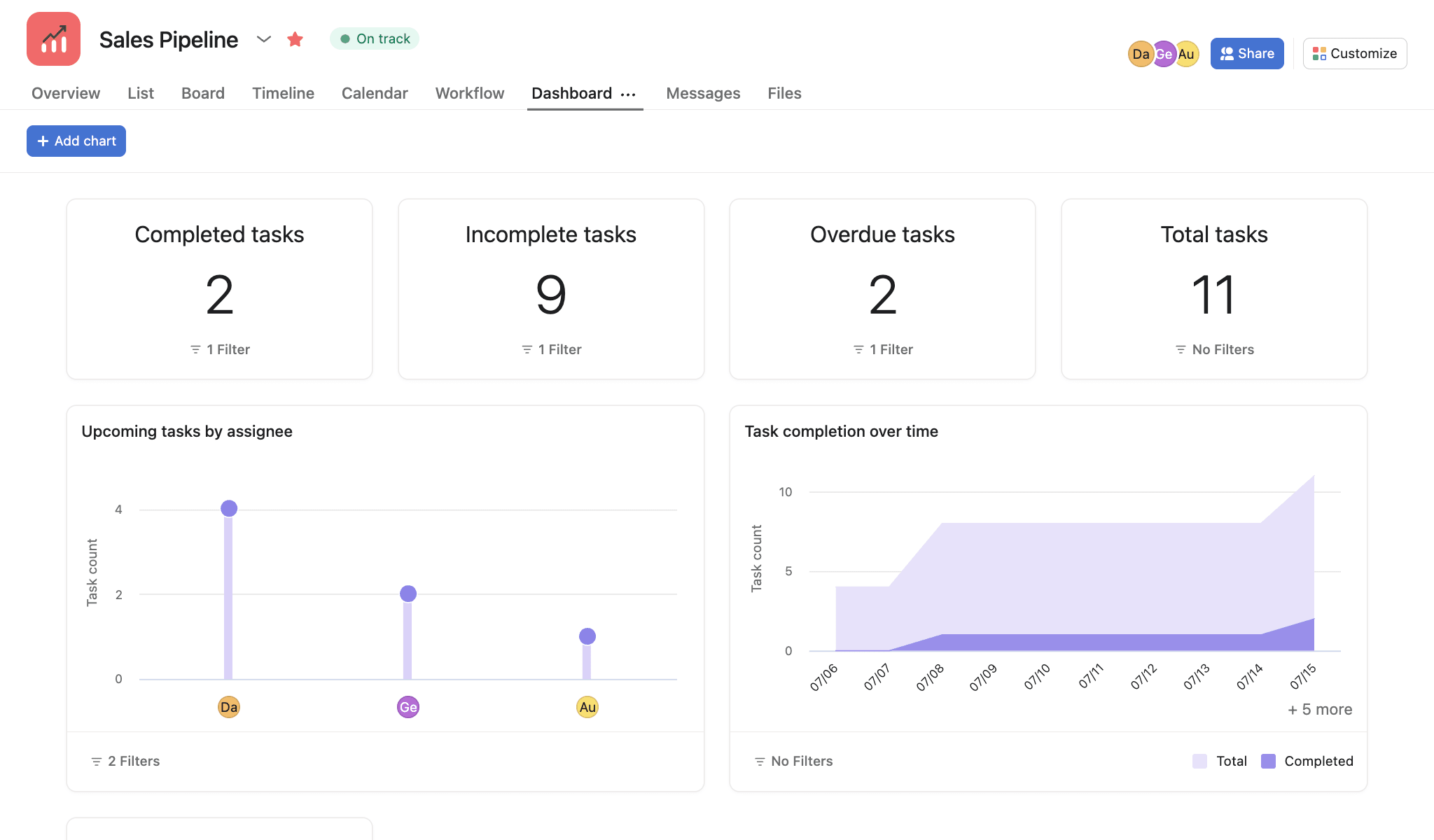
Asana’s reporting dashboard can be customized with the data you want to see first. Gather analytics and insights on your team’s spending, progress, projects by status, and more.
Workflow management

Build customized workflows for anything from sales pipelines to marketing campaigns. With Asana, you can track your team’s workflows and monitor them through multiple views like calendar, timeline, lists, and more.
Portfolio management
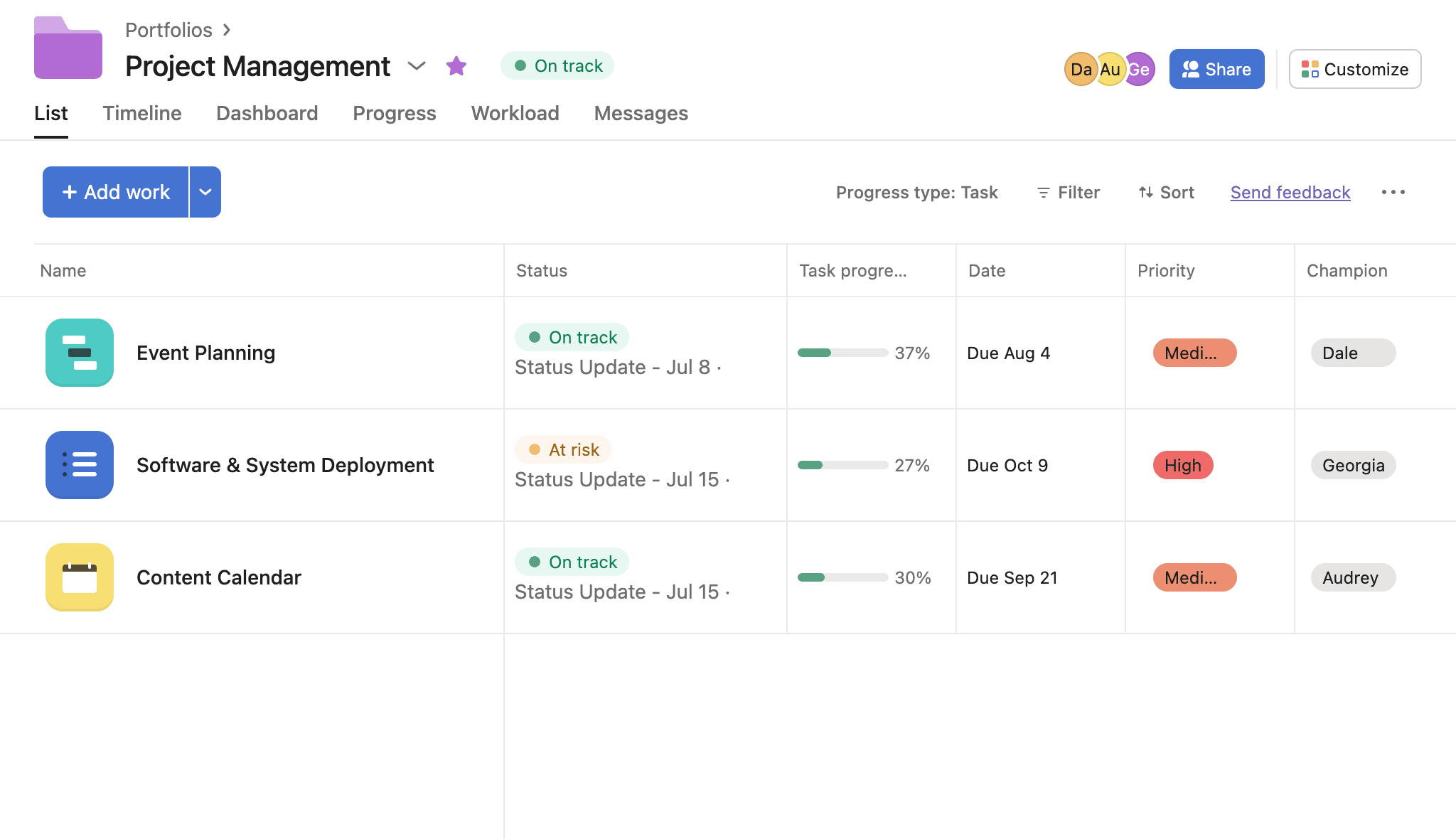
Manage multiple projects at once and organize them into labeled portfolios. Monitor progress and analytics on each individual portfolio to see how work is advancing in real-time.
Related: Asana project management, Asana work management
monday work management features
Because monday work management allows organizations to build their own products — be it a hiring pipeline for HR or a supply management solution for IT — its features are simple to use, set up, and master. Here’s a look at key monday work management features.
Dashboards
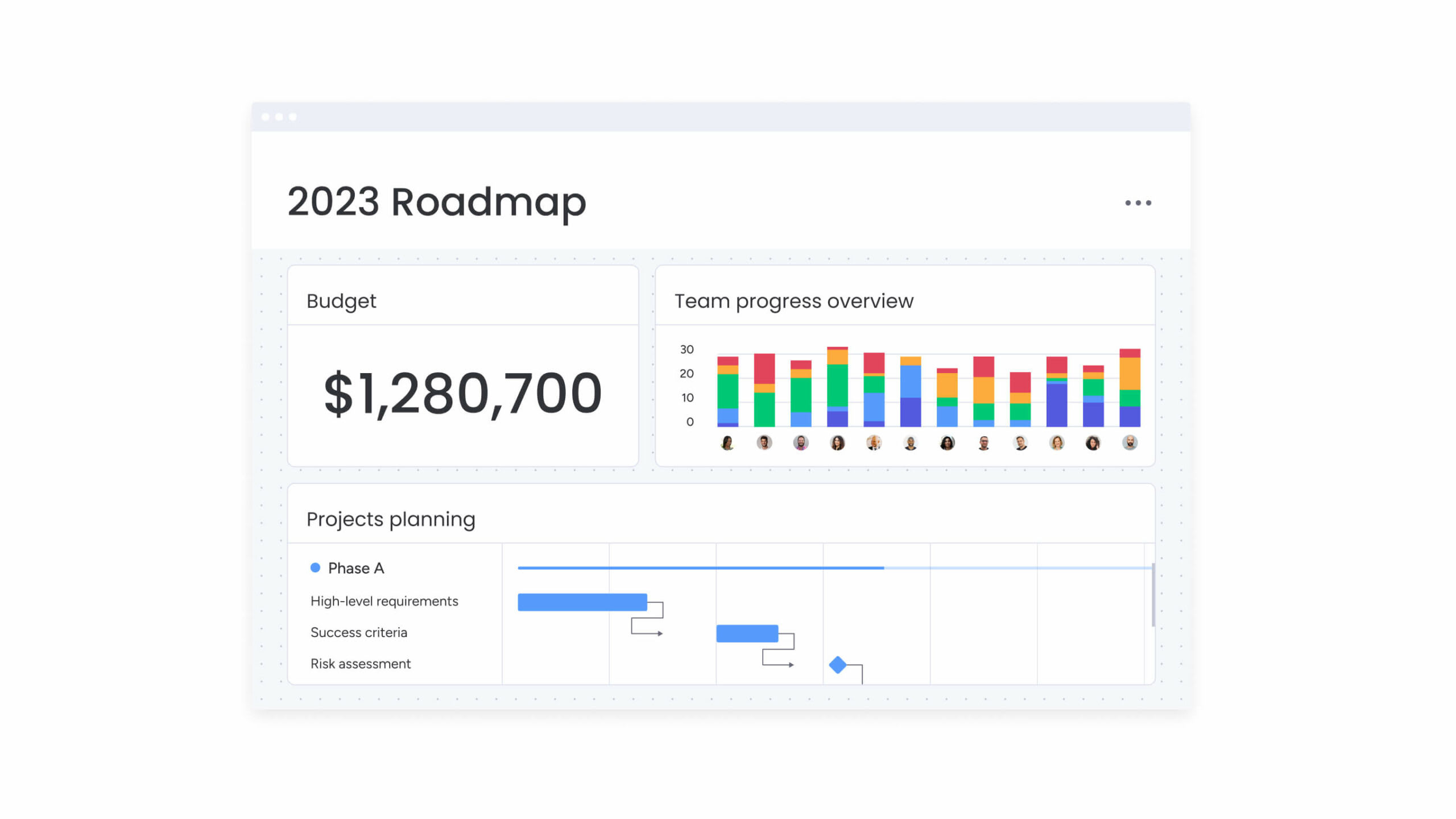
See the status of your projects at a glance with clear, visual, and intuitive project dashboards to stay on track and reach your goals. Easily create summaries and reports, and get a high-level view of your work to make data-driven decisions.
Views
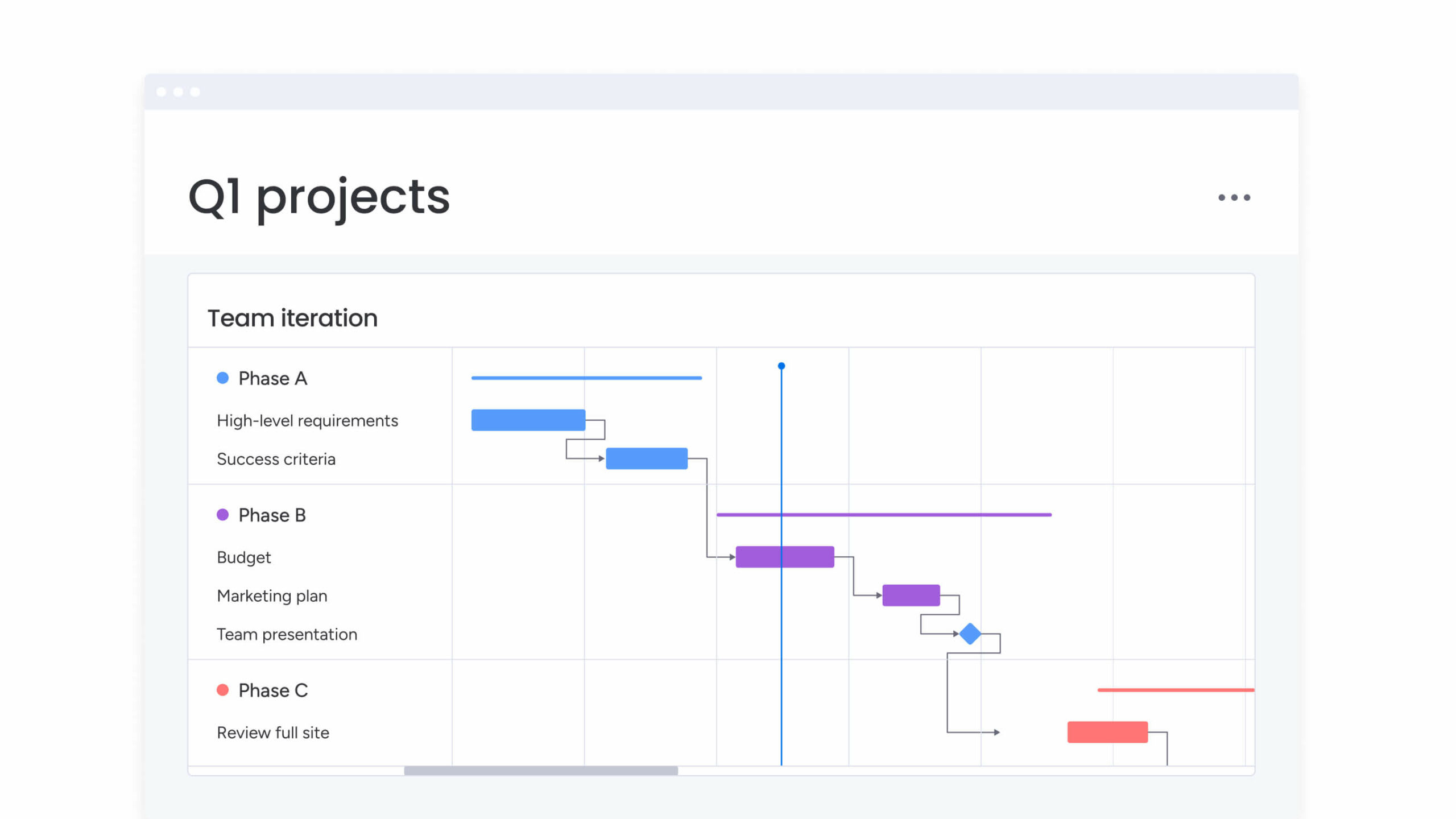
monday.com offers 27+ views, including Kanban, Gantt, Calendar, Timeline, Map, and Chart Views, for a holistic overview of your projects from any angle.
Automations
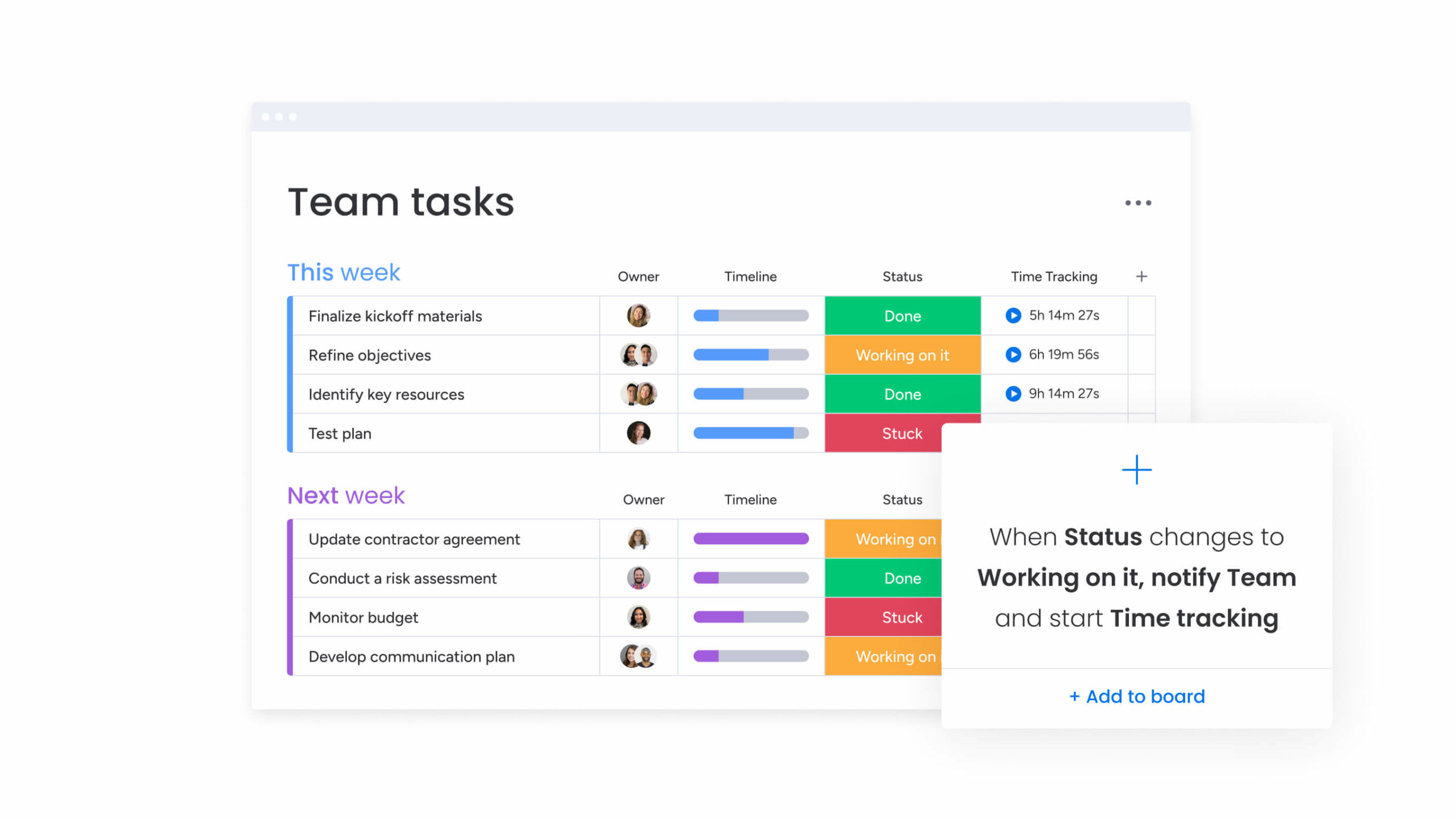
Save time by automating repetitive and mundane tasks in seconds, so your team can focus on the work that really makes an impact. For example, send automatic reminders or start time tracking when a project status changes.
Collaboration
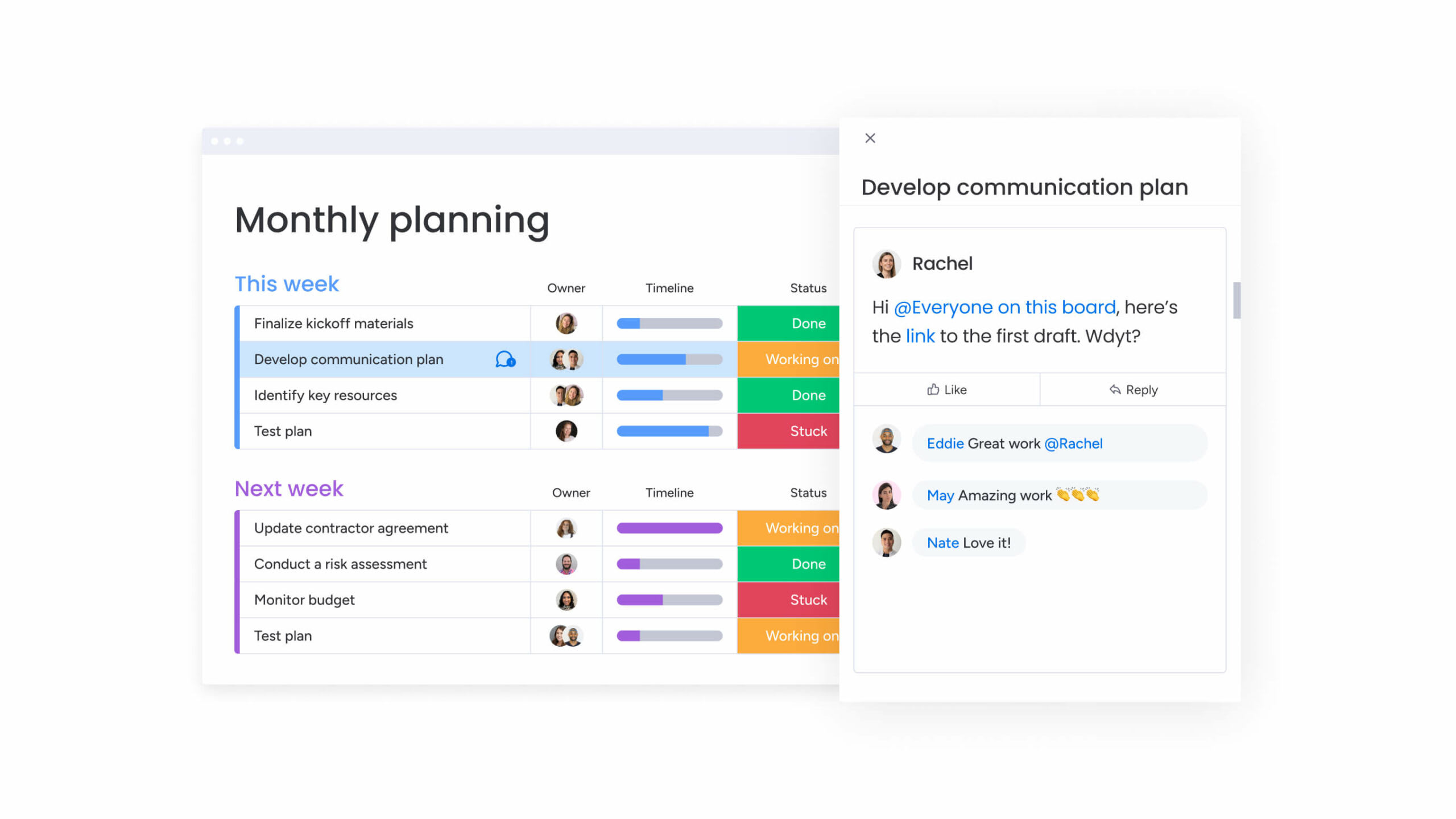
monday work management’s collaboration features eliminate the need for painfully long email threads and unnecessary meetings. All team communication and files are centralized in one place and kept within the context of your work, so you never miss any critical information.
Task management
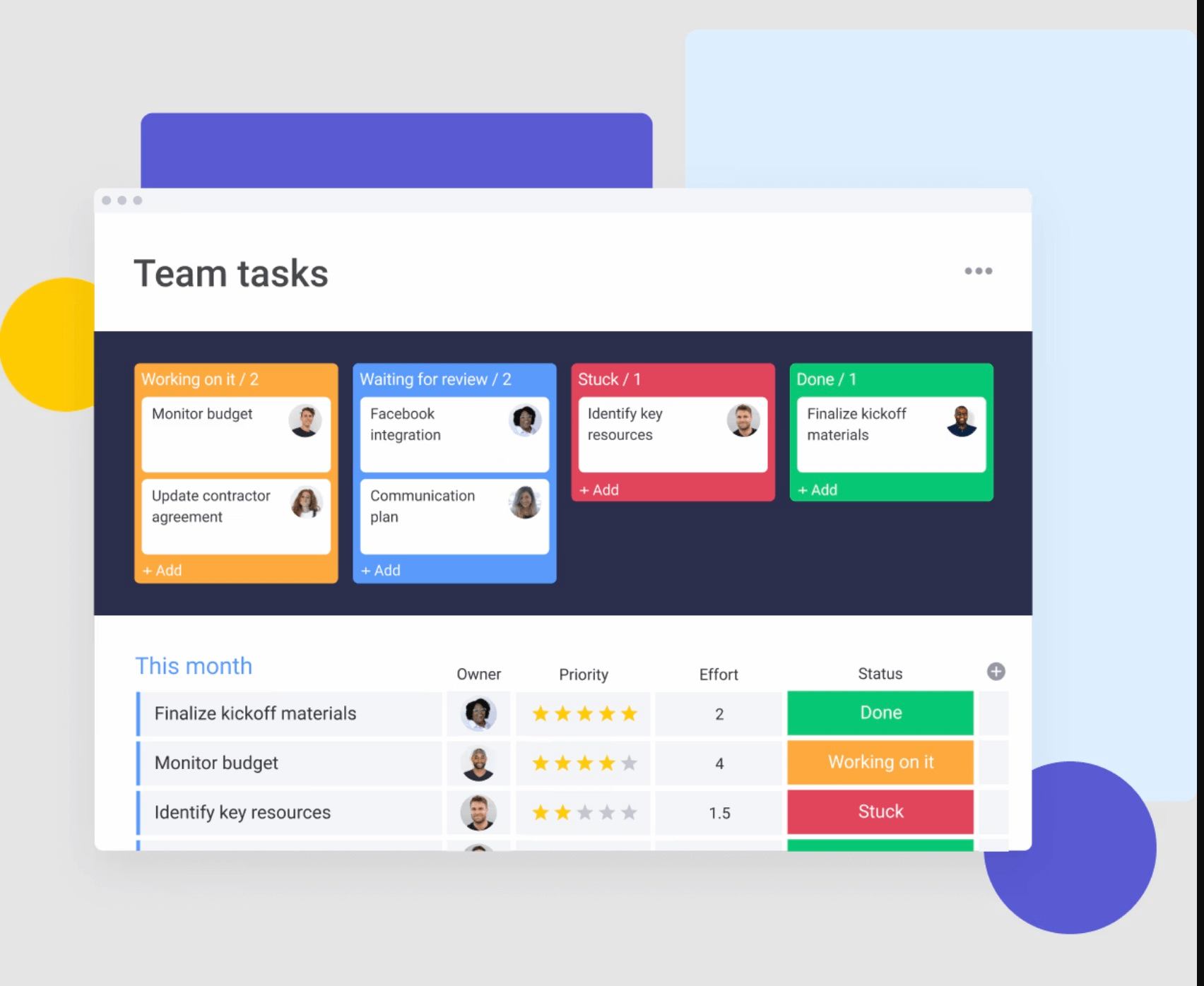
Manage all your tasks in one cohesive platform. monday work management helps you minimize manual tasks with automations and turns your tasks list into a unique workflow for stronger collaboration.
Analytics
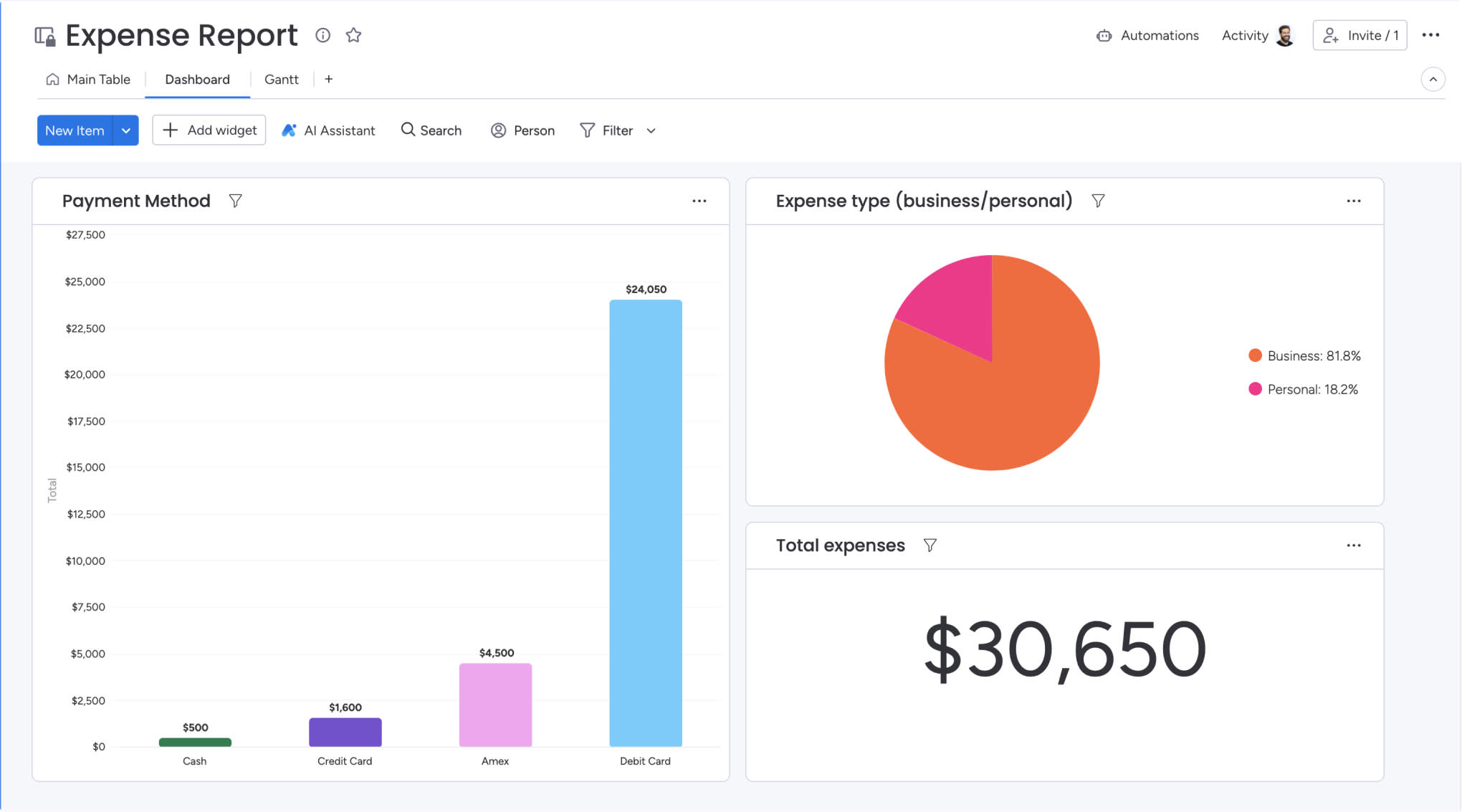
Get access to advanced reporting that can be customized to your needs. Visualize your team’s workload, spending, tasks on the schedule, and track your team’s performance to analyze productivity and output.
Workflow management
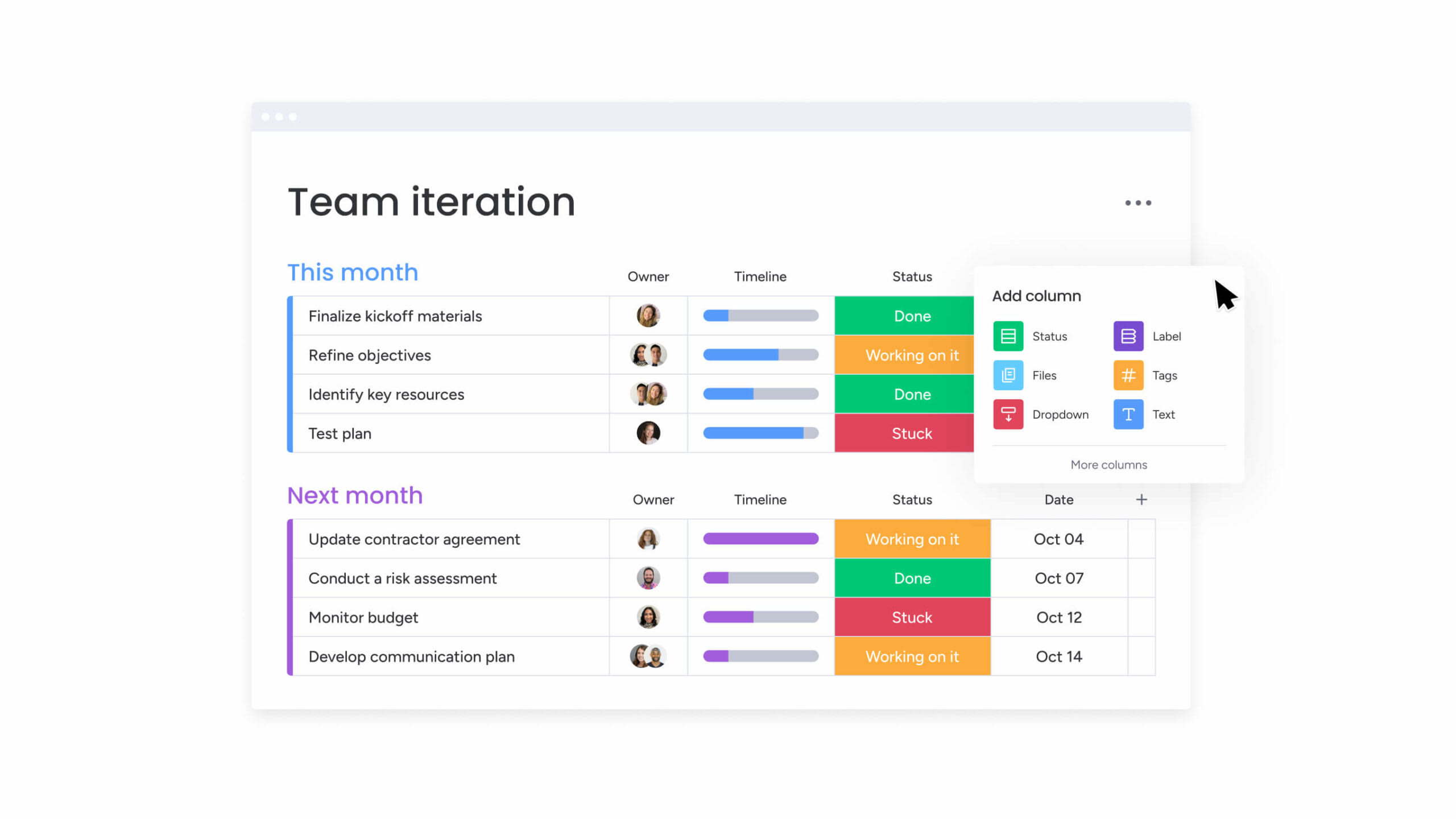
With monday work management, you can instantly automate your own custom workflows. For example, automate due date notifications so tasks never slip through the cracks and integrate with third-party tools to boost your workflows.
Portfolio management
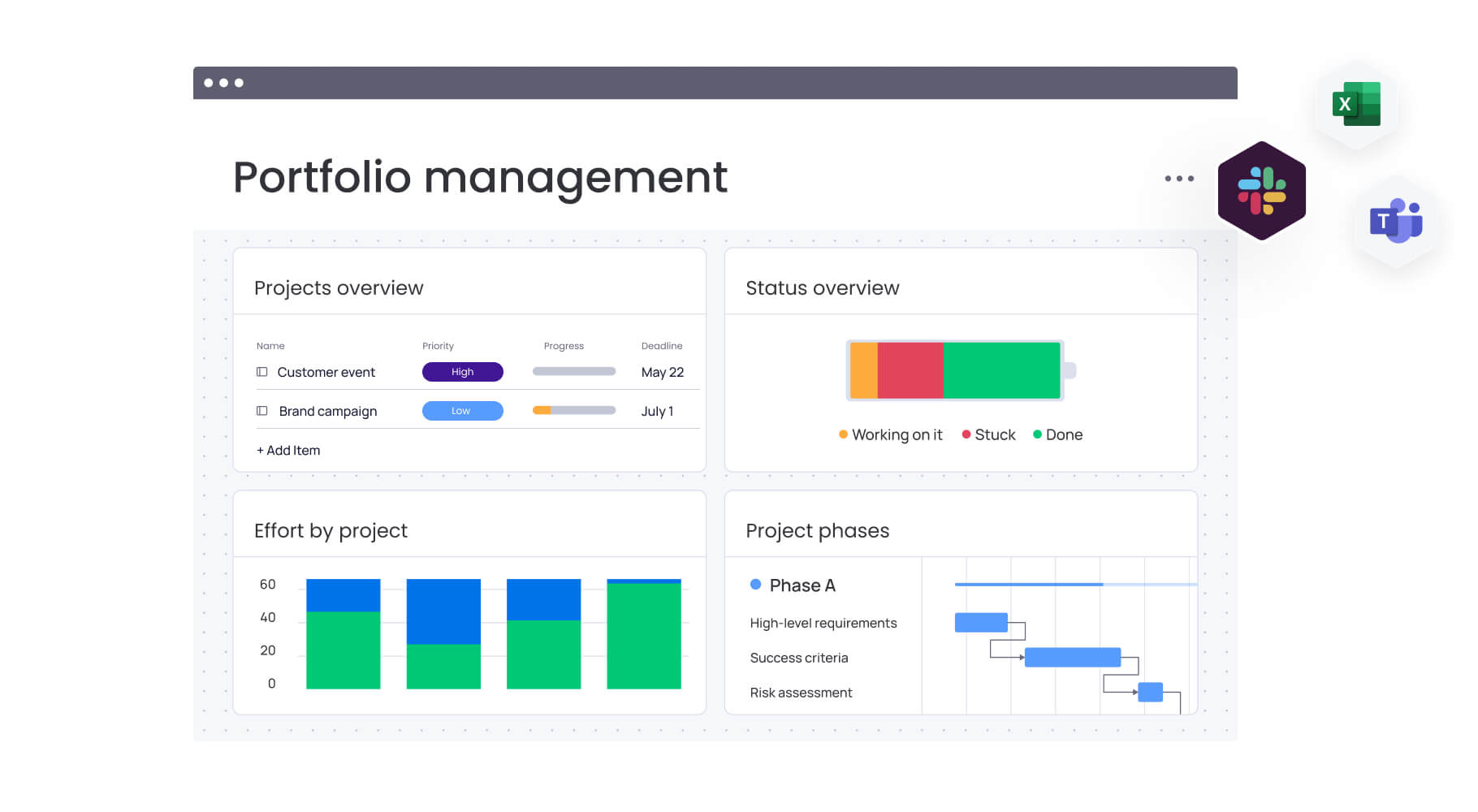
Create custom portfolios to group tasks and ongoing projects together. With monday work management, you can prioritize projects, create custom fields, track resources and funding on each, and get a high-level overview of all your portfolios at once.
Get startedSecurity: monday work management provides transparent security measures
Security is an important consideration no matter the industry you’re working in, but for some fields like medicine, law, and others, it’s a top priority. Let’s look at the different security features both platforms offer.
Asana security
Asana prides itself on a trustworthy platform that’s used by thousands of users. Its infrastructure is designed with layers of protection and is compliant with global and regional regulations and standards. Here are some security standards Asana complies with:
- GDPR
- SOC 2
- HIPPA
- CSA
- FERPA
- GLBA
- ISO 27001
monday work management security
As a company, monday.com is committed to keeping user data secure. The platform is both compliant and transparent, allowing users to understand how their information is stored and handled. monday.com follows strict international security standards such as:
- ISO 27001
- ISO 27017
- ISO 27018
- HIPAA
- GDPR
- AICPA SOC1, SOC2, SOC3
- CSA
- And others
Integrations: monday work management offers more integration options
Third-party integrations make a robust project management platform even more useable. By integrating the work tools your team already uses, you can continue certain workflows as-is and enhance them with the help of a project management platform. Asana and monday.com both extend their functionality by integrating with other tools you already use.
Asana integrations
Asana integrates with over 100 products that can easily connect to its platform through third-party app integrations. Choose from integrations with apps like Slack, Adobe Creative Cloud, and Vimeo so that you can work on every project in one place.
monday.com integrations
Connect your data with 200+ apps tools across departments so everyone can access the same data quickly and efficiently, focus on their strategic work, and stop switching between apps. monday.com integrates with platforms like Salesforce, Zoom, Google apps, SurveyMonkey, Zapier, and others. It also offers an integration for Asana if you want to use both platforms for different purposes.
Pricing: Asana’s free forever plan is enticing, but monday work management’s paid plans offer better value
Pricing is one of the key considerations when debating between software options. While your budget can decide on the platform you select, it’s important to also consider value per plan when weighing different options. Check Asana and monday work management plans and prices to see what’s offered by both.
Asana pricing
Asana pricing includes multiple plans, including a free basic plan and two premium plans with a 30-day free trial to test the functionality. Let’s take a look at what core features you get in each one.
Personal
Asana’s free Basic Plan suits individuals or small teams of less than 15 people just starting with project management who want to manage tasks and personal to-do lists. It includes:
- Unlimited tasks, projects, and messages
- Unlimited storage and activity log
- List, board, and calendar views
- Project Overview and Brief
- 100+ free integrations
- iOS and Android apps
Starter
Asana’s Starter plan — from $10.99 per user per month (billed annually) — enables teams to create and track projects confidently. It includes everything in the Personal package, plus:
- Timeline
- Workflow Builder
- Milestones
- Forms
- Unlimited dashboards
- Advanced search and reporting
Advanced
Asana’s Advanced plan — from $24.99 per user per month (billed annually) — allows teams and companies to manage work across multiple projects. It includes all the Premium features, plus:
- Portfolios
- Goals
- Workload
- Custom rules builder
- Forms branching and customization
- Time tracking
- Advanced integrations
- Scaled security
Enterprise and Enterprise+
Asana’s Enterprise plans requires teams to contact sales for a quote and caters to larger organizations that need centralized visibility, control, and support. It includes advanced admin and security features, such as:
- Asana AI
- Security Assertion Markup Language (SAML)
- User and group provisioning and de-provisioning (SCIM)
- Audit Log API (built to support SIEM)
- Data loss prevention (DLP) and export
- Cross-regional backups
- 24/7 support
monday.com pricing
monday.com offers four premium pricing plans and a 14-day free trial (no credit card required) to test all its advanced features. monday work management pricing operates on a “price-per-seat” model. How much you pay will depend on how many seats you need, what features you’re looking for, and whether you want to pay annually or monthly.
Basic
The Basic Plan — from $9 per seat per month (billed annually, min 3 seats at $27/month) — lets solopreneurs and small teams organize their tasks in one place and create a dashboard based on one board. It includes everything in the Individual package, plus:
- Unlimited items, docs, boards, and free viewers
- 200+ templates
- 35+ column types
- Kanban view
- Prioritized customer support
- iOS and Android apps
Standard
The Standard plan — from $12 per seat per month (billed annually, min 3 seats at $36/month) — enables medium-sized teams to collaborate and optimize their team processes and create a dashboard that combines up to 5 boards. It includes everything in the Basic package, plus:
- Timeline, Gantt, and calendar views
- Advanced search functionality
- Guest access
- Automations (250 actions per month)
- Integrations (250 actions per month)
Pro
The Pro plan — from $19 per seat per month (billed annually, min 3 seats at $57/month) — allows you to streamline and run your teams’ complex workflows and create a dashboard that combines up to 10 boards. It includes all the Standard features, plus:
- Private boards and docs
- Chart view
- Time tracking
- Formula column
- Automations (25,000 actions per month)
- Integrations (25,000 actions per month)
Enterprise
The Enterprise plan needs a customized quote from the sales team and lets you create a dashboard that combines up to 50 boards and caters to larger organizations requiring more advanced solutions and security, such as:
- Enterprise-grade security and governance
- Enterprise-scale automations and integrations
- Advanced reporting and analytics
- Multi-level permissions
- Tailored onboarding
- Premium support
Ease of use: monday work management offers more flexibility with fewer hurdles
While neither Asana nor monday.com is especially difficult to use, adopting a new platform can always be challenging for some users. Here’s a closer look at the user experience of each one.
Asana ease of use
Asana users note that the software is straightforward to use and understand, as the colors, grids, and toggles help you find your way around. It has all the essential project management features, and the mobile app makes information available on the go.
On the other hand, some users said it takes time to get up to speed on the software. According to an Asana user on TrustRadius, the software “was not as intuitive to understand and start using” as expected.
Users unfamiliar with the platform might need help getting started, but once they get the hang of it, Asana is relatively user-friendly. Still, other users felt Asana needed an easier way to “link hierarchical tasks, projects, and their dependencies.”
monday work management ease of use
monday.com users note that the software is intuitive and user-friendly, even if you’re not particularly tech-savvy. They find it easy to navigate the platform and use the features, plus the library of 200+ templates helps users to get started quickly.
Of course, new users might encounter a few hurdles. According to one monday.com user on TrustRadius, the Support Team is “extremely quick to respond if you’ve ever got an inquiry that the support articles don’t immediately answer.” Elsewhere on TrustRadius, another user said monday.com is the “easiest, most comprehensive, and most customizable” platform.
Get startedSupport: monday work management includes more well-rounded support options
The best software is affordable, feature-rich, and flexible, but a top-notch project management platform also needs great support. Let’s see how Asana and monday work management stack up.
Asana customer support
Unlike competitors, Asana does not offer support by phone. For those comfortable reaching out virtually, Asana allows customers to get in touch through email and chat support. Premium customers can also access the Asana Academy, customer success webinars, knowledge base, and troubleshooting videos.
monday work management support
At monday.com, all customers get 24/7 support every day of the year, anytime, anywhere. Aside from phone support, customers can also receive help through email, a contact form on the website, a community forum, a knowledge base, and videos.
Customer reviews: Users love both, but monday.com has a slight edge
A great way to determine whether a piece of software suits your business is to find out what other customers say about it on review and comparison sites like G2 and TrustRadius. Asana and monday.com both score well on these sites, with monday.com garnering the highest rating.
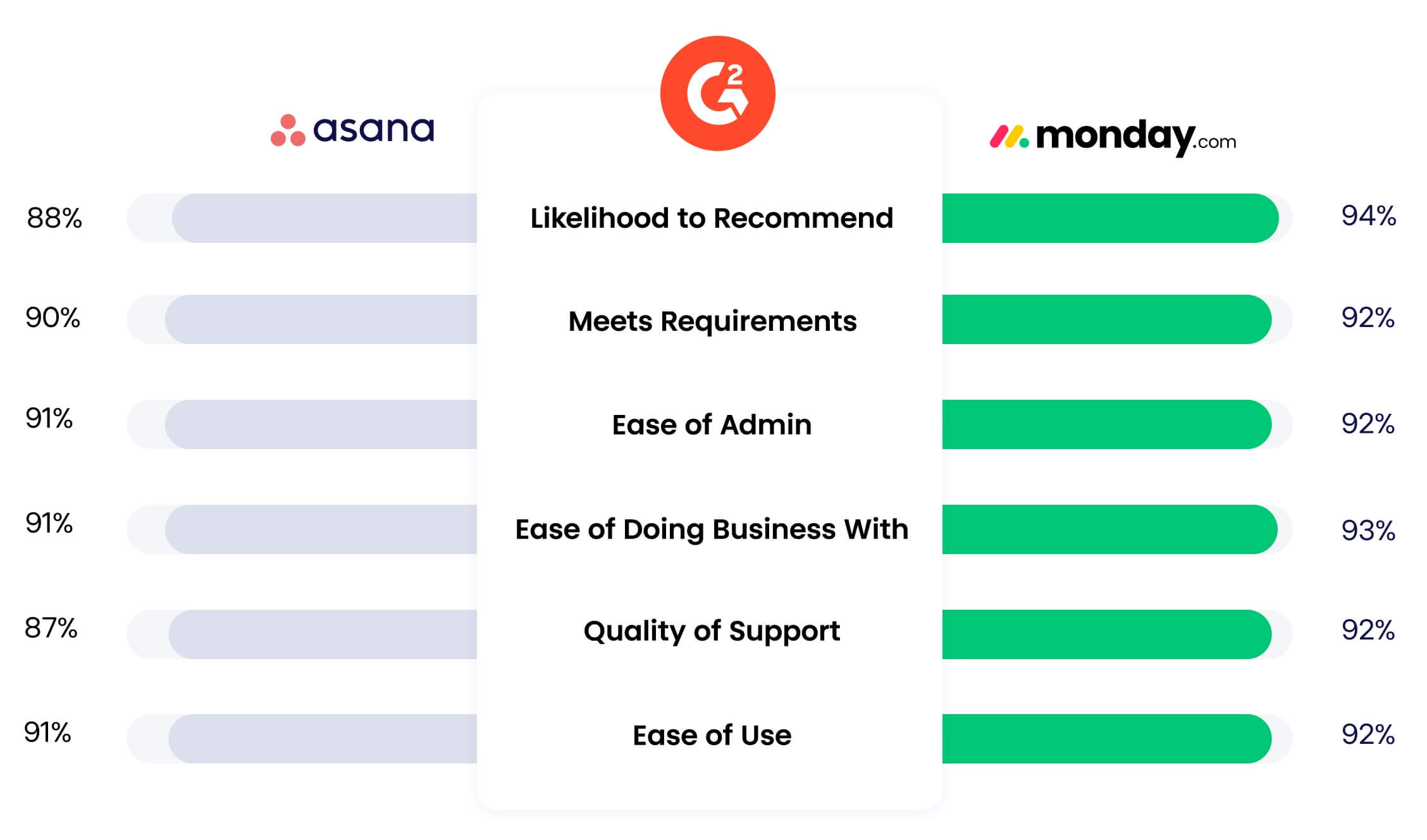
Asana customer reviews
G2 review: 4.4/5 based on over 10,000 reviews
Here’s what one G2 reviewer said about Asana support:
“Asana always keeps up to date in terms of tracking tools for all my projects and tasks in one place. The customer support is relatively fast and they answer our questions accurately and directly.”
monday.com customer reviews
G2 review: 4.7/5 based on over 12,000 reviews
Here’s how one G2 reviewer rated monday.com:
“In-app notifications, training, help, and support are the best I’ve seen in a software product. You can track what is new to monday.com (and easily enable beta features if you’d like), set up training workspaces, and react to new developments all in the app.”
monday work management vs. Asana: which is right for you?
Both Asana and monday work management offer impressive features to manage projects, track tasks, collaborate across teams, and generate reports. Based on your team’s needs, you might consider different options:
- Go with monday work management if you want an affordable and well-rounded, customizable platform that will help your team collaborate on projects and tasks and want access to more support options
- Go with Asana if your team is smaller and more tech-savvy and doesn’t require as much support and you want to focus more deeply on task management
All things considered, Asana’s free plan is a great starting point for small teams with unlimited tasks and projects. It also includes 100+ software integrations with unlimited actions, so it’s easy to sync with your other essential apps.
For larger teams, the Pro plan from monday work management ($19/seat/month) is superior to Asana’s Advanced plan ($24.99/user/month). The robust work management platform gives you access to flexible building blocks like integrations, automations, and dashboards, allowing you to build a customized workflow for any team and function. Plus, you get more features, like column types, view options, hundreds of ready-made templates, and 24/7 customer support on all pricing plans. With monday work management, you can create a single source of truth for your team.
G2 reviewers rated monday.com better than Asana for meeting their business needs and having better ongoing product support. Reviewers also preferred the direction, feature updates, and product roadmaps offered by monday.com over Asana.
Which is the right platform for better project management?
Now that you have all the information on Asana and monday work management, which will you choose? While it’s true that there’s no one size fits all solution for every team, it’s important to consider key factors like customization capabilities and scalability. Opting for a tool that manages to remain flexible while still offering robust task and project management tools will serve you better in the long run, which is why we think monday work management is the better option for most teams.
Get started
Related articles: Asana alternatives, Asana vs. ClickUp, Asana vs. Jira, Asana vs. Wrike, Asana vs. Airtable, Asana vs. Trello, Asana vs. Smartsheet, monday.com alternatives
FAQ
What is Asana?
Asana is a work management platform to improve team collaboration and project management. Founded in 2008 by former Facebook executives, Asana aims to “help everyone track their work” by providing one place to manage projects, focus on what’s important, assign tasks to team members, set deadlines, and organize work in one place for seamless collaboration.
What is monday.com?
monday.com is a Work Operating System (Work OS) – an open platform where teams can create solutions to become more agile, get more done, and grow with the business. The cloud-based software allows teams to create custom workflows to plan, run, and track processes, projects, and everyday work.
Organizations and teams of all types and sizes can benefit from the monday.com Work OS. For instance, a sales team could build a CRM, marketing could use it to plan campaigns, and developers could use it to track bugs.
How does Asana compare to monday.com?
When comparing the two platforms, monday.com comes out to be slightly more affordable with plans that offer more features. In that sense, you get better value for your monday. Additionally, monday.com has better user reviews and offers more support options than Asana.
Is Asana the same as monday.com?
While both platforms help teams manage projects and tasks, they’re not quite the same. Asana is more fitting for smaller teams like start-ups and is more focused on task management, while monday.com can fit any sized team and has features to handle more complex projects.
Can you connect Asana to monday.com?
Yes, monday.com offers an Asana integration, making it possible for both platforms to work together harmoniously. This can come in handy if different teams or departments are using different platforms, or if your team is using both for different needs.
 Get started
Get started 

